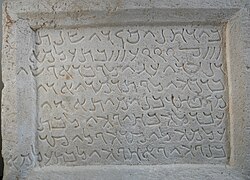lingvo.wikisort.org - Alphabet
The Palmyrene alphabet was a historical Semitic alphabet used to write Palmyrene Aramaic. It was used between 100 BCE and 300 CE in Palmyra in the Syrian desert. The oldest surviving Palmyrene inscription dates to 44 BCE.[2] The last surviving inscription dates to 274 CE, two years after Palmyra was sacked by Roman Emperor Aurelian, ending the Palmyrene Empire. Use of the Palmyrene language and script declined, being replaced with Greek and Latin.
| Palmyrene alphabet | |
|---|---|
 Palmyrene inscribed tablet in the Musée du Louvre | |
| Script type | Abjad
|
Time period | 100 BCE to 300 CE |
| Direction | right-to-left script |
| Languages | Palmyrene Aramaic |
| Related scripts | |
Parent systems | Proto-Sinaitic alphabet
|
Sister systems | Ammonite Brāhmī [a] Edessan[1] Elymaic[1] Hatran[1] Hebrew Mandaic[1] Nabataean[1] Pahlavi Parthian |
| ISO 15924 | |
| ISO 15924 | Palm (126), Palmyrene |
| Unicode | |
Unicode alias | Palmyrene |
Unicode range | U+10860–U+1087F Final Accepted Script Proposal |
[a] The Semitic origin of the Brahmic scripts is not universally agreed upon. | |

The Palmyrene alphabet was derived from cursive versions of the Aramaic alphabet and shares many of its characteristics:[3][4]
- Twenty-two letters with only consonants represented
- Written horizontally from right-to-left
- Numbers written right-to-left using a non-decimal system
Palmyrene was normally written without spaces or punctuation between words and sentences (scriptio continua style).
Two forms of the Palmyrene alphabet were developed: The rounded, cursive form derived from the Aramaic alphabet and later a decorative, monumental form developed from the cursive Palmyrene.[2] Both the cursive and monumental forms commonly used orthographic ligatures.[4]
Characters
Numbers
Palmyrene used a non-decimal system which built up numbers using combinations of their symbols for 1, 2, 3, 4, 5, 10, and 20.[4] It is similar to the system used for Aramaic which built numbers using their symbols for 1, 2, 3, 10, 20, 100, 1000, and 10000.[5]
Letters
There are some styles in which the 'r'-letter (resh) is the same as the 'd'-letter (dalesh) with a dot on top, but[vague] there are styles in which the two letters are visually distinct. Ligation, after b, ḥ, m, n, and q before some other consonants was common in some inscriptions but was not obligatory. There are also two fleurons (left-sided and right-sided) that tend to appear near numbers.
Decipherment
Examples of Palmyrene inscriptions were printed as far back as 1616, but accurate copies of Palmyrene/Greek bilingual inscriptions were not available until 1753.[6] The Palmyrene alphabet was deciphered in 1754, literally overnight, by Abbé Jean-Jacques Barthélemy using these new, accurate copies of bilingual inscriptions.
Unicode
Palmyrene was added to the Unicode Standard in June, 2014 with the release of version 7.0.
The Unicode block for Palmyrene is U+10860–U+1087F:
| Palmyrene[1] Official Unicode Consortium code chart (PDF) | ||||||||||||||||
| 0 | 1 | 2 | 3 | 4 | 5 | 6 | 7 | 8 | 9 | A | B | C | D | E | F | |
| U+1086x | 𐡠 | 𐡡 | 𐡢 | 𐡣 | 𐡤 | 𐡥 | 𐡦 | 𐡧 | 𐡨 | 𐡩 | 𐡪 | 𐡫 | 𐡬 | 𐡭 | 𐡮 | 𐡯 |
| U+1087x | 𐡰 | 𐡱 | 𐡲 | 𐡳 | 𐡴 | 𐡵 | 𐡶 | 𐡷 | 𐡸 | 𐡹 | 𐡺 | 𐡻 | 𐡼 | 𐡽 | 𐡾 | 𐡿 |
Notes
| ||||||||||||||||
Gallery
- Funerary slabstone bearing a Palmyrene inscription (Musée du Louvre)
- Relief with Palmyrene/Greek bilingual inscription (Musée du Louvre)
- Column at Palmyra with Palmyrene/Greek bilingual inscription in honor of Julius Aurelius Zenobius
References
- Daniels, Peter T.; Bright, William, eds. (1996). The World's Writing Systems. Oxford University Press, Inc. pp. 89. ISBN 978-0195079937.
- "Palmyrenian alphabet". Encyclopædia Britannica.
- Daniels, Peter T.; Bright, William, eds. (1996). The World's Writing Systems. Oxford University Press, Inc. ISBN 978-0195079937.
- Everson, Michael (17 August 2010). "N3867R2: Proposal for encoding the Palmyrene script in the SMP of the UCS" (PDF). Retrieved 20 August 2016.
- Everson, Michael (25 August 2007). "N3339: Proposal for encoding the Imperial Aramaic script in the SMP of the UCS" (PDF). Retrieved 6 July 2014.
- David, Madeleine-V. (1961). En marge du mémoire de l'abbé Barthélemy sur les inscriptions phéniciennes (1758). p. 41.
На других языках
- [en] Palmyrene alphabet
[ru] Пальмирский алфавит
Пальмирский алфавит — это консонантный алфавит семитского типа, ответвление арамейского и предок сирийских письменностей. Направление алфавита левостороннее. Алфавит во многом аналогичен стилизованному курсиву «квадратного» еврейского письма. Центр распространения — город в Сирийской пустыне Пальмира, или Тадмор, или Тамар. Пальмирские надписи были найдены в Пальмире, Дура-Европосе, Палестине, в Египте и других районах Северной Африки, а также в развалинах древних Том (Констанца) на Чёрном море, в Венгрии, в Италии и даже в Англии[1].Другой контент может иметь иную лицензию. Перед использованием материалов сайта WikiSort.org внимательно изучите правила лицензирования конкретных элементов наполнения сайта.
WikiSort.org - проект по пересортировке и дополнению контента Википедии


